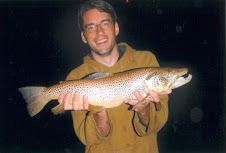Fishing a small stream can be frustrating. At times devoid of fish, and at times loaded with them. Figuring out the timing in these streams can be a daunting task. One day you think will be perfect turns out to be a bust. A day starting with low expectations ends with double digit hookups on steelhead. You just never know how the fishing will be, and this is the beauty of creeking.
Productive fishing in small streams requires stealth and adaptability, in that order. Stealth is required to stalk the fish in the shallower rivers, and good adaptability allows the fisherman to fish every spot properly. On any given creeking river, I will employ 3 tactics so as to fish every spot. The first is my go-to method, the bobber. The second my old go-to method, chuck and duck (except with split shot, not a sliding weight). The third is a method I learned from a regular on a river I used to fish. It involved, in his case, a large pyramid sinker and spawn. He would basically "glue" this rig to the bottom, and then wait for a steelhead to bite. It was very effective. I adopted his rig, and scaled it down for fly fishing. It too has turned out to be very effective.
Learning these methods is essential to creeking. Hiring a knowledgeable guide can help tremendously. More just a fish locater, a good guide can give a client knowledge they will employ for the rest of their fishing life. The ability to read water is a perfect example of also a quality a good guide will give you. Below you will find pictures and descriptions of 3 types of water one will find on any given great lakes stream. They are nowhere near all of the types of water a fisherman will encounter. But all of them, at certain points of the year, will hold fish.
THE SLIDE

This type of run is a "pinch point," explained as a point in the river that concentrates fish during heavy runs. Spots like this produce on both big and small rivers alike. In small streams however, they are very important.
POCKET WATER

This type of water holds fish before, during, and after the spawn. When you see long faces around shallow gravel, look to the pockets for fish
SLOW POOLS

Great winter time holding water. Take a long slow pool and dissect it piece by piece until you hookup or cover the hole. If you do hookup, let the hole rest and then fish it again...
These 3 types of water can hold fish both individually or consecutively during a run. Learning where steelhead are located and the techniques used to catch them will greatly enhance your time spent on the water. There is nothing like leaving the stream with a smile on your face.




No comments:
Post a Comment